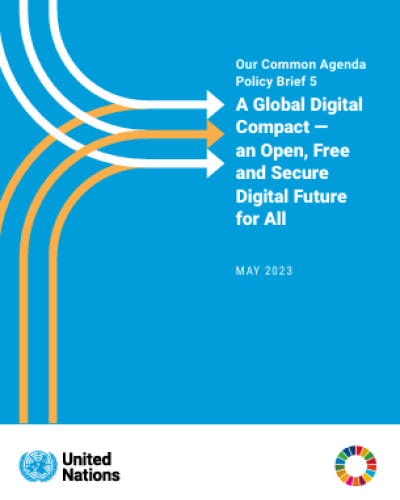Our Common Agenda Policy Brief 5 -A Global Digital Compact: an Open, Free and Secure Digital Future for Al

The present brief proposes the development of a Global Digital Compact that would set out principles, objectives and actions for advancing an open, free, secure and human-centred digital future, one that is anchored in universal human rights and that enables the attainment of the Sustainable Development Goals. It outlines areas in which the need for multi-stakeholder digital cooperation is urgent and sets out how a Global Digital Compact can help to realize the commitment in the declaration on the commemoration of the seventy-fifth anniversary of the United Nations (General Assembly resolution 75/1) to “shaping a shared vision on digital cooperation” by providing an inclusive global framework. Such a framework is essential for the multi-stakeholder action required to overcome digital, data and innovation divides and to achieve the governance required for a sustainable digital future. Our digital world is one of divides.
In 2002, when governments first recognized the challenge of the digital divide, 1 billion people had access to the Internet. Today, 5.3 billion people are digitally connected, yet the divide persists across regions, gender, income, language, and age groups. Some 89 per cent of people in Europe are online, but only 21 per cent of women in low-income countries use the Internet. While digitally deliverable services now account for almost two thirds of global services trade, access is unaffordable in some parts of the world. The cost of a smart phone in South Asia and sub-Saharan Africa is more than 40 per cent of the average monthly income, and African users pay more than three times the global average for mobile data.
Fewer than half of the world’s countries track digital skills, and the data that exist highlight the depth of digital learning gaps. Two decades after the World Summit on the Information Society, the digital divide is still a gulf. Data divides are also growing. As data are collected and used in digital applications, they generate huge commercial and social value. While monthly global data traffic is forecast to grow by more than 400 per cent by 2026, activity is concentrated among a few global players.
Many developing countries are at risk of becoming mere providers of raw data while having to pay for the services that their data help to produce. The innovation divide is even more stark. Digital technologies have moved beyond the Internet and mobile devices into autonomous intelligent systems and networks, generative artificial intelligence (AI), virtual and mixed reality, distributed ledger technologies (such as blockchain), digital currencies and quantum technologies.
The wealth generated by these innovations is highly unequal, dominated by a handful of big platforms and States. Inequality is rising. Enormous investments in technology have not been accompanied by spending on public education and infrastructure. Digital technology has led to massive gains in productivity and value, but these benefits are not resulting in shared prosperity. The wealth of those in the top 1 per cent is growing exponentially: between 1995 and 2021, they accounted for 38 per cent of the increase in global wealth, while the bottom 50 per cent accounted for only 2 percent.
Digital technologies are accelerating the concentration of economic power in an ever-smaller group of elites and companies: the combined wealth of technology billionaires, $2.1 trillion in 2022, is greater than the annual gross domestic product of more than half of the Group of 20 economies.






